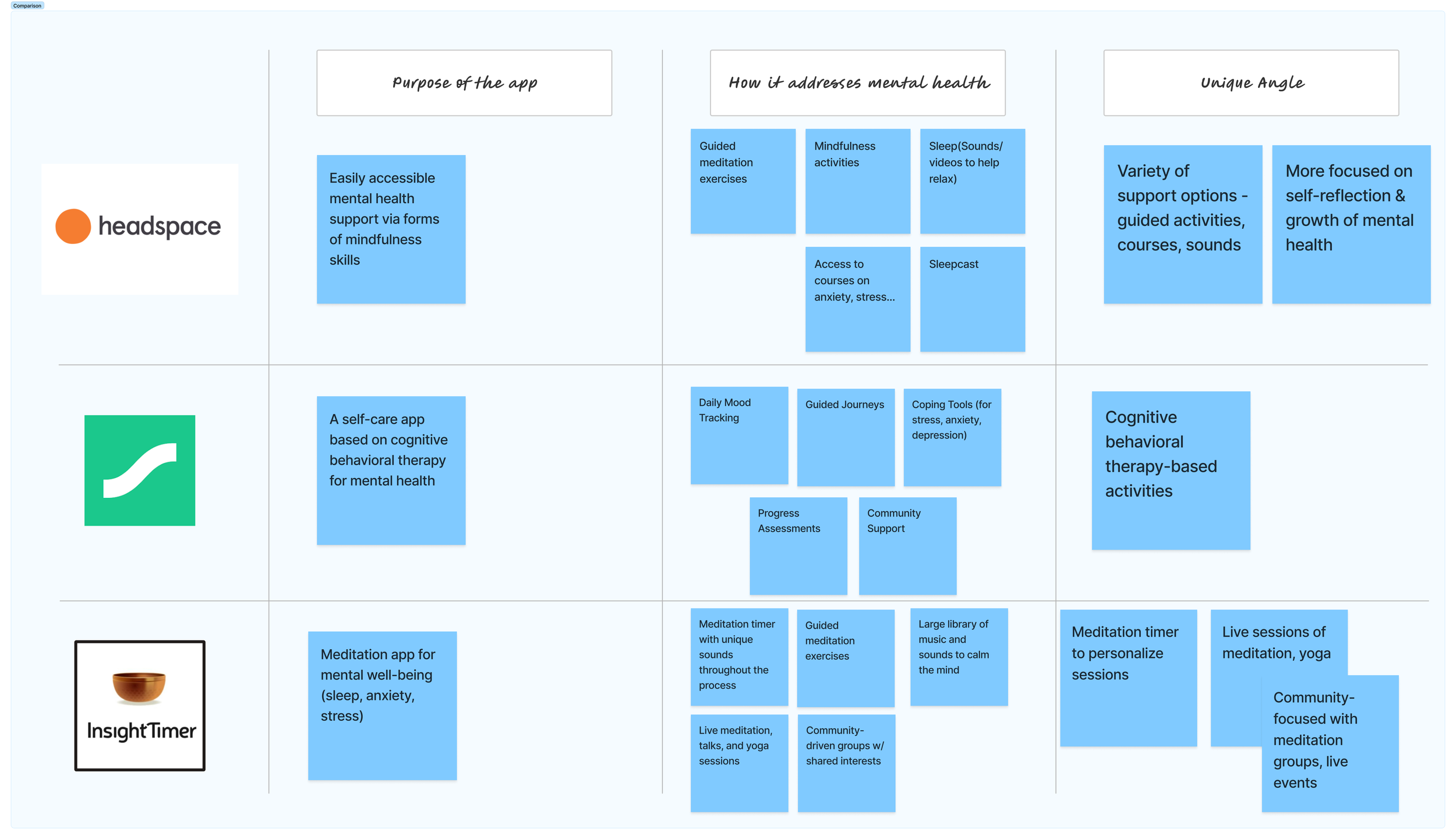MindShare
Mental Health
Mobile-app
Purpose: Health Informatics Class Project
Role: Lead UX Researcher & UX Designer
Duration: Jan. 2024 - Mar. 2024 (~2.5 months)
Overview/Background
As I entered the final quarter of my time in college, I took a course called Informatics 172, where it was essentially a Health Informatics Project class. I was tasked with the quarter-long project of designing some sort of ‘solution’ to mental health. This meant it could be a wearable health device like the Oura Ring, or a mobile app to manage mental wellbeing such as Headspace. Presented with this opportunity, I personally expressed my interest to my team in designing an app; the idea of creating a concept of a physical health product was daunting, but an app gave me the chance to practice and strengthen my UX skillset. Thus, my team moved forward with the idea of a mobile app which would eventually become MindShare.
My team, when presented with this project, thought about how mental health applied to our own lives. The first thing that came to mind was, “We’re college students”, and we’re always swamped with coursework from various classes. From attending classes anytime from 8:00 am to as late as 9:00 pm throughout the week, we agreed that our mental health took a toll because of the amount of anxiety and stress caused by college.
My team decided to focus on an audience we’re well familiar with, and expanding our reach a little, we included working professionals, who we felt would face similar issues of a busy schedule due to 9-5 jobs. Our solution would be a mobile-based application that aids the mental wellbeing of busy college students and working professionals.
The Problem/Goal
Understand
Current Landscape
fl;kdjasfjdskla;f
jldfk;sajfkl;sdjfklsdal;
Define
Current Landscape
fl;kdjasfjdskla;f
jldfk;sajfkl;sdjfklsdal;
A Quest-based Mental Health App to promote Mental Wellbeing via Motivation
UX Design
Tools: Figma, Miro, Google Docs, Google Forms, Google Sheets, Zoom, Discord
College students tend to face busy day-to-day schedules filled with attending classes, doing assignments, and studying, all while trying to maintain some semblance of free time and relaxation. This may lead to a lack of focus on one’s mental health (speaking from experience).
We must figure out how our audience currently faces their mental wellbeing, and how a mobile app can help alleviate their problems.
Ideate
Current Landscape
fl;kdjasfjdskla;f
jldfk;sajfkl;sdjfklsdal;
Next Steps
Current Landscape
fl;kdjasfjdskla;f
jldfk;sajfkl;sdjfklsdal;
Research here… H3 for main questions/provoking titles?…H2 for main takeaways
Prototype & Test
Current Landscape
fl;kdjasfjdskla;f
jldfk;sajfkl;sdjfklsdal;
UX Research
UNDERSTAND
UNDERSTAND
Before talking to our users, we wanted to first get a solid understanding of the current landscape of mental health apps:
Exploring the Mental Health App Landscape - What are they doing? What can WE do?
Competitive Analysis
Looking at the available mental health apps, I wanted to understand how current apps are tackling mental health in the space; these were my guiding points:
Purpose of the app
How The App Addresses Mental Health
Does it have a “unique angle”?
Competitive Analysis of 3 Mental Health Apps
Self-care appears to be the main focus of current mental health apps.
Guided meditation, access to self-learning courses, coping tools (for stress, anxiety…)
Many features are shared, the difference is how they are presented.
Guided courses focused on self-reflection, Cognitive Behavioral Therapy activities…
Community is a secondary focus; noticeable lack of user interaction.
Live meditation & yoga sessions, Community Group Chats…
An Opportunity Spotted! The First Step Taken
Post-competitive analysis, I felt that there was a clear direction we could head towards with our app. Building off of the insights gained:
We’ve established that self-care seems to be the core of current apps.
Users can take their pick at any of the mental health apps and get some form of mental health guidance.
If one doesn’t satisfy them, they could try another one. And yet…
“74% of users stop using health apps upon 10th use” - A Study on Mental Health Mobile App Usage
I believe current mental health apps provide the right tools and methods for mental health & wellbeing, but struggle to maintain their users’ continued interest.
So, what can we do?
Find a unique way to engage users with their mental health - Quests
Have an “anchor” to keep users coming back after their initial visit - that’s something we might have stumbled upon in our competitive analysis - Community
Going into user surveys & interviews, I definitely wanted to:
Better understand the mental health state of busy college students
Gauge interest in a Quest-based mental health app
How do busy college students feel about mental health apps?
User Surveys
In a survey totaling 23 responses, we found that 60.9% of participants had never used a mental health app before, and for those who did, 50% never, or rarely, ever used the apps they downloaded.
Many participants cited cost, premium features, and skepticism of the apps’ benefits as main deterrents to their interest.
Knowing that, I wanted to then find out what might interest or engage users in mental health apps to prove them beneficial; in particular, I wanted to prod the idea of Quests, as that was MindShare’s core concept.
User Interviews
Of the 23 responses we received from surveys, we were able to gather 10 participants for user interviews. In these interviews, to understand what might be implemented in our app, I wanted to primarily focus on discovering:
Mental health state & coping mechanisms
Desires that can translate into Mental Health Apps
Interest in a Quest-focused mental health app




